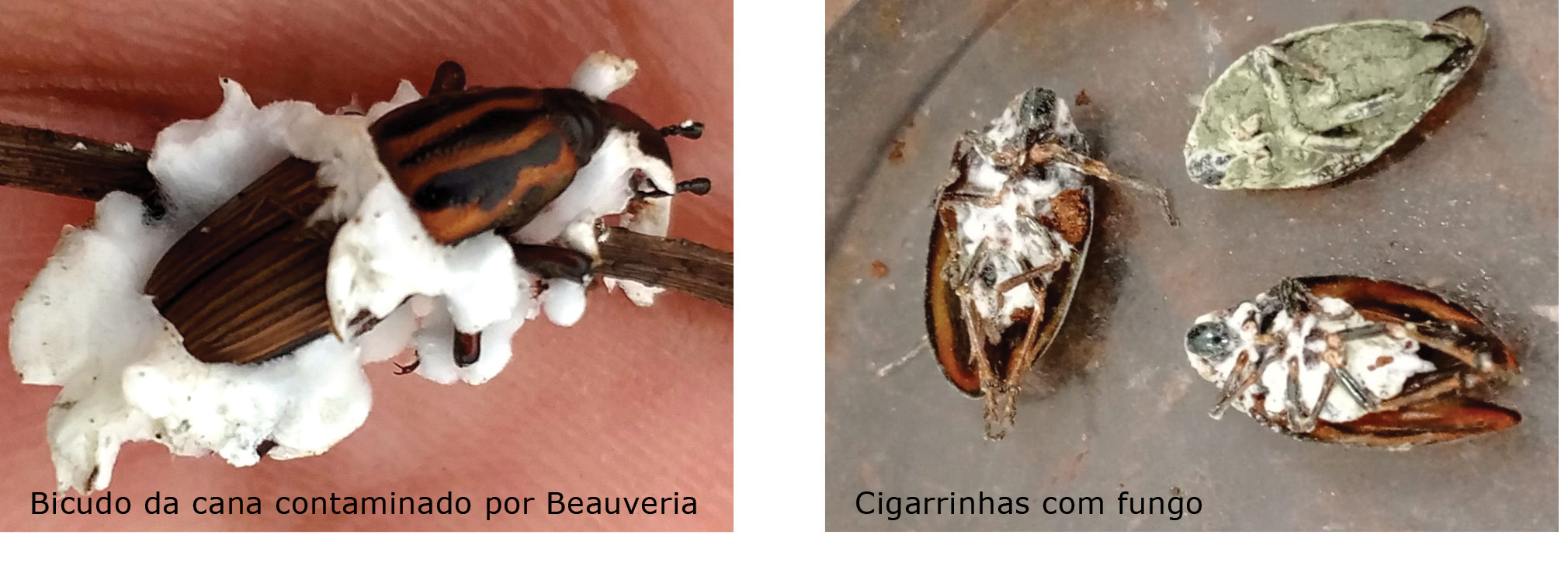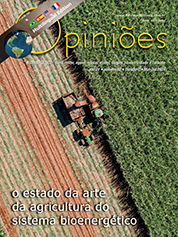Roberto Teixeira Alves
Pesquisador da Embrapa Cerrados
OpAA80
Bioinsumos para controle de insetos-praga
Temos testemunhado nos últimos anos, uma grande evolução na produção e utilização de bioinsumos no Brasil, principalmente no setor sucroalcooleiro. Primeiramente, precisamos entender o que são os bioinsumos ou insumos biológicos. São “produtos ou processos agroindustriais desenvolvidos a partir de enzimas, extratos (de plantas ou de microrganismos), microrganismos, macrorganismos (invertebrados), metabólitos secundários e feromônios, destinados ao controle biológico de pragas, e também os ativos voltados à nutrição, os promotores de crescimento de plantas, os mitigadores de estresses bióticos e abióticos e os substitutivos de antibióticos” (Embrapa, 2023).
A utilização de bioinsumos para controle de insetos-praga de diferentes culturas tem aumentado bastante, e na cultura da cana-de-açúcar tem-se ótimos exemplos. Com a expansão de um cultivo, como o da própria cana, faz com que as barreiras naturais diminuam como a vegetação nativa, permitindo o aparecimento ou o aumento de diferentes insetos-praga.
O ideal é que sempre se faça o manejo integrado dessas pragas. E o controle biológico é um dos métodos que fazem parte desse manejo integrado. Ele consiste no controle de pragas por meio de inimigos naturais (bioinsumos), para manter os níveis de população dessas pragas em equilíbrio, sem dar prejuízos econômicos ao produtor rural.
O Programa Nacional de Bioinsumos, bem como o Conselho Estratégico do Programa Nacional de Bioinsumos, foram instituídos através do Decreto Nº 10.375, de maio de 2020. O objetivo do referido programa é, sobretudo, reduzir a dependência de insumos importados e alavancar, de forma sustentável, o uso do potencial da nossa biodiversidade, e isso é bastante positivo para o nosso país.
Os dados de mercado de bioinsumos são periodicamente coletados em grandes empresas do setor pela Croplife. Em 2023, foi divulgado um estudo (CropLife e S&P Global) projetando um valor de R$ 17 bilhões para o mercado de bioinsumos até 2030, com taxa de crescimento entre 2022 e 2023 de 23%.
A cultura da cana-de-açúcar no Brasil é uma das que mais utiliza o controle biológico, sendo que emprega esse tipo de controle em 4,5 milhões de hectares de cana, que correspondem a um pouco mais da metade da área total de cana no Brasil. Isto também se deve ao alto nível de conscientização dos dirigentes do setor sucroalcooleiro. Existem vários insetos-praga que atacam a cana-de-açúcar.
Dentre eles, se destacam as cigarrinhas da raiz-da-cana Mahanarva spp, o bicudo-da-cana Sphenophorus levis e a broca-da-cana Diatraea saccharalis. Tanto as ninfas (forma jovem) quanto os adultos das cigarrinhas-da-raiz da cana sugam a seiva da planta, sendo que o adulto, além de sugar, injeta uma toxina nas folhas, causando um amarelecimento e secamento das pontas, diminuindo a produtividade da cana entre 15 e 80% por hectare, dependendo da intensidade do ataque.
O bioinsumo mais utilizado para o controle de cigarrinhas é o produzido à base do fungo Metarhizium anisopliae. Esse fungo já vem sendo utilizado no Brasil desde a década de 1970. Com o passar do tempo, novas cepas mais eficientes foram selecionadas e produzidas em maior escala, além de uma evolução na formulação desse bioinsumo e nas técnicas de aplicação no campo.
A formulação mais antiga desse fungo é a granulada, com o fungo desenvolvido nos grãos de arroz. Outra formulação é a do tipo pó
molhável, que é composta por esporos puros misturados com algum inerte para dar maior volume. E há a formulação que utiliza óleo adjuvante emulsionável, que é a chamada dispersão oleosa ou até de suspensão emulsionável ou concentrada.
Esta formulação apresenta diversas vantagens como: maior eficiência para matar o inseto-praga; maior adesividade na folhagem e no corpo do inseto; maior proteção dos esporos contra a radiação ultravioleta; menor evaporação da calda aplicada; maior espalhamento na folhagem e no corpo do inseto, o que aumenta a área de contato com a praga; maior tempo de armazenamento em temperatura ambiente; e facilidade no transporte e na aplicação. É também aplicada através de pulverizadores tratorizados ou de aviões agrícolas.
Esta formulação apresenta diversas vantagens como: maior eficiência para matar o inseto-praga; maior adesividade na folhagem e no corpo do inseto; maior proteção dos esporos contra a radiação ultravioleta; menor evaporação da calda aplicada; maior espalhamento na folhagem e no corpo do inseto, o que aumenta a área de contato com a praga; maior tempo de armazenamento em temperatura ambiente; e facilidade no transporte e na aplicação. É também aplicada através de pulverizadores tratorizados ou de aviões agrícolas.
O bicudo-da-cana Sphenophorus levis talvez seja a principal praga da cana, especialmente no estado de São Paulo. Ele age da seguinte forma: após acasalamento, as fêmeas perfuram com as mandíbulas os tecidos sadios do rizoma da cana, na base das brotações, abaixo do nível do solo. Inserem os ovos individualmente a até 4 mm no interior dos colmos. Isso causa perdas de 20-30 toneladas de cana por hectare/ano e redução da longevidade do canavial.
O nível de dano econômico é de, no máximo, 3% de tocos atacados. Canaviais com mais de 30% de tocos atacados vão para a reforma imediatamente. O bioinsumo mais utilizado para controle dessa praga é o fungo Beauveria bassiana que pode ser adquirido nas diferentes formulações já citadas e aplicado com o equipamento tratorizado chamado de cortador de soqueira ou com barras pulverizadoras com bicos hidráulicos em pingentes ao longo da linha de cana.
O nível de dano econômico é de, no máximo, 3% de tocos atacados. Canaviais com mais de 30% de tocos atacados vão para a reforma imediatamente. O bioinsumo mais utilizado para controle dessa praga é o fungo Beauveria bassiana que pode ser adquirido nas diferentes formulações já citadas e aplicado com o equipamento tratorizado chamado de cortador de soqueira ou com barras pulverizadoras com bicos hidráulicos em pingentes ao longo da linha de cana.
Outra praga importante na cultura da cana é a broca-da-cana, Diatraea saccharalis. Essa praga pode causar danos no cultivo de cana como interferência no crescimento de brotos e perfilhos, morte das gemas, tombamento das plantas, secamento dos ponteiros (coração morto), formação de brotações laterais e enraizamento aéreo. Os bioinsumos mais indicados para o controle da broca-da-cana são à base de vespinhas parasitas da broca ou parasitas de ovos da mariposa de Diatraea saccharalis.
A vespinha Cotesia flavipes é utilizada em mais de 4 milhões de hectares de canaviais, onde parasita a fase de lagarta. Já a vespinha Trichogramma galloi é parasita de ovos da mariposa de Diatraea saccharalis. Atualmente a liberação dessas duas vespinhas no canavial é feita através de drones, que fazem uma distribuição mais eficiente desse tipo de bioinsumo no campo.
A produção de bioinsumos on farm tem crescido muito em nosso país, mas, para que seja de boa qualidade, é necessário que o produtor invista bem em equipamentos e treinamentos de pessoal e que tenha um ambiente asséptico para evitar contaminações no produto desejado. Atualmente, existem 617 bioinsumos registrados para controle de pragas, que podem ser encontrados no aplicativo do Mapa/Embrapa chamado de Bioinsumos, disponibilizado de forma gratuita nas plataformas Play Store e Apple Store.
A vespinha Cotesia flavipes é utilizada em mais de 4 milhões de hectares de canaviais, onde parasita a fase de lagarta. Já a vespinha Trichogramma galloi é parasita de ovos da mariposa de Diatraea saccharalis. Atualmente a liberação dessas duas vespinhas no canavial é feita através de drones, que fazem uma distribuição mais eficiente desse tipo de bioinsumo no campo.
A produção de bioinsumos on farm tem crescido muito em nosso país, mas, para que seja de boa qualidade, é necessário que o produtor invista bem em equipamentos e treinamentos de pessoal e que tenha um ambiente asséptico para evitar contaminações no produto desejado. Atualmente, existem 617 bioinsumos registrados para controle de pragas, que podem ser encontrados no aplicativo do Mapa/Embrapa chamado de Bioinsumos, disponibilizado de forma gratuita nas plataformas Play Store e Apple Store.
O que se pretende, com a maior utilização de bioinsumos, é evitarmos as aplicações de produtos químicos ou minimizá-las, proporcionando uma proteção maior do meio ambiente, menos resíduos nos alimentos e menos intoxicações de seres humanos e animais. A busca por um mundo melhor tem de ser constante em nossos pensamentos.





